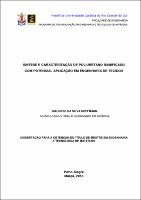| Share record |


|
Please use this identifier to cite or link to this item:
https://tede2.pucrs.br/tede2/handle/tede/6853Full metadata record
| DC Field | Value | Language |
|---|---|---|
| dc.creator | Hoffmann, Mauricio da Silva | - |
| dc.creator.Lattes | http://buscatextual.cnpq.br/buscatextual/visualizacv.do?id=K4450298U8 | por |
| dc.contributor.advisor1 | Ligabue, Rosane Angélica | - |
| dc.contributor.advisor1Lattes | http://buscatextual.cnpq.br/buscatextual/visualizacv.do?id=K4784426H5 | por |
| dc.date.accessioned | 2016-07-26T14:16:17Z | - |
| dc.date.issued | 2016-03-04 | - |
| dc.identifier.uri | http://tede2.pucrs.br/tede2/handle/tede/6853 | - |
| dc.description.resumo | Poliuretanos (PU) têm sido amplamente utilizados como biomaterial por possuir boa compatibilidade e desejáveis propriedades mecânicas e os poliuretanos ramificados tem apresentado além destas características, apreciável estabilidade a degradação hidrolítica e enzimática. Dentro deste contexto, este trabalho teve como objetivo sintetizar poliuretanos ramificados estáveis a partir da adição de pentaeritritol e avaliar seu potencial uso como suportes em engenharia tecidual. Para a síntese do PU ramificado foi utilizado o poliol policaprolactona diol (PCL) e pentaeritritol (PETT) em diferentes quantidades (5, 10 e 15% m/m em relação ao poliol), bem como, o hexametilenodiisocianato (HDI). Estes PU ramificados (PU-PETT) foram avaliados quanto às propriedades estruturais, morfológicas, mecânicas, térmicas e de solubilidade em diversos solventes orgânicos e comparados ao PU linear (sem PETT). Entre os PU ramificados, o PU-PETT 5% apresentou melhores características morfológicas e de resistência a tração, por isso ele foi utilizado para preparar membranas lixiviadas juntamente com o PU linear. As membranas lixiviadas foram avaliadas quanto as suas propriedades estruturais, morfológicas, mecânicas, térmicas, molhabilidade, degradação hidrolítica calcificação e grau de inchamento. A membrana lixiviada de PU-PETT 5% apresentou alta porosidade e interconectividade, maior estabilidade térmica comparada a membrana lixiviada de PU linear, apesar do menor grau de cristalinidade e massa molar. Além disso, a membrana de PU-PETT 5% apresentou habilidade para a biomineralização de fosfato de cálcio, boa molhabilidade, maior estabilidade a degradação hidrolítica e maior grau de inchamento quando comparado a membrana de PU linear. Com isso, pode-se concluir que a membrana de PU-PETT 5% apresentou características adequadas para uso como biomaterial em engenharia de tecidos. | por |
| dc.description.abstract | Polyurethanes (PU) are widely used as biomaterials because it has good compatibility, and desirable mechanical properties and branched polyurethanes have shown besides these characteristics, an appreciable stability to hydrolytic and enzymatic degradation. Within this context, this study aimed to synthesize branched polyurethanes from the addition of pentaerythritol and evaluate its potential use as scaffolds in tissue engineering. Polycaprolactone diol (PCL) as polyol and pentaerythritol (PETT) in different amounts (5, 10 and 15% w/w relative to the polyol) as well as the hexamethylene diisocyanate (HDI) were used in the synthesis of the branched PU. These branched PU (PU-PETT) were evaluated for structural, morphological, mechanical, thermal and solubility in various organic solvents and compared to the linear PU (without PETT). Among the branched PU, PU-PETT 5% showed better morphological and tensile strength characteristics, so it was used to prepare membranes leached with the linear PU. The leached membranes were evaluated for their structural, morphological, mechanical, thermal properties, wettability, hydrolytic degradation, calcification and swelling degree. The leached membrane PU-PETT 5% showed high porosity and interconnectivity, greater thermal stability compared to linear PU leached membrane, despite the lower degree of crystallinity and molar weight. Also, the PU-PETT 5% membrane exhibited the ability of calcium phosphate biomineralization, good wettability, higher stability hydrolytic degradation and greater swelling as compared to linear PU membrane. Thus, it can be concluded that the membrane PU-PETT 5% exhibited characteristics suitable for use as biomaterials in tissue engineering. | eng |
| dc.description.provenance | Submitted by Setor de Tratamento da Informação - BC/PUCRS ([email protected]) on 2016-07-26T14:16:17Z No. of bitstreams: 1 DIS_MAURICIO_DA_SILVA_HOFFMANN_COMPLETO.pdf: 3702613 bytes, checksum: 3b0ef365d0e0899c33cdef47ae74d886 (MD5) | eng |
| dc.description.provenance | Made available in DSpace on 2016-07-26T14:16:17Z (GMT). No. of bitstreams: 1 DIS_MAURICIO_DA_SILVA_HOFFMANN_COMPLETO.pdf: 3702613 bytes, checksum: 3b0ef365d0e0899c33cdef47ae74d886 (MD5) Previous issue date: 2016-03-04 | eng |
| dc.format | application/pdf | * |
| dc.thumbnail.url | http://tede2.pucrs.br:80/tede2/retrieve/165797/DIS_MAURICIO_DA_SILVA_HOFFMANN_COMPLETO.pdf.jpg | * |
| dc.language | por | por |
| dc.publisher | Pontifícia Universidade Católica do Rio Grande do Sul | por |
| dc.publisher.department | Faculdade de Engenharia | por |
| dc.publisher.country | Brasil | por |
| dc.publisher.initials | PUCRS | por |
| dc.publisher.program | Programa de Pós-Graduação em Engenharia e Tecnologia de Materiais | por |
| dc.rights | Acesso Aberto | por |
| dc.subject | POLIURETANOS | por |
| dc.subject | BIOPOLÍMEROS | por |
| dc.subject | ENGENHARIA TECIDUAL | por |
| dc.subject | ENGENHARIA DE MATERIAIS | por |
| dc.subject.cnpq | ENGENHARIAS | por |
| dc.title | Síntese e caracterização de poliuretano ramificado com potencial aplicação em engenharia de tecidos | por |
| dc.title.alternative | Synthesis and characterization of branched polyurethane with potential application in tissue engineering. | eng |
| dc.type | Dissertação | por |
| Appears in Collections: | Programa de Pós-Graduação em Engenharia e Tecnologia de Materiais | |
Files in This Item:
| File | Description | Size | Format | |
|---|---|---|---|---|
| DIS_MAURICIO_DA_SILVA_HOFFMANN_COMPLETO.pdf | Texto Completo | 3.62 MB | Adobe PDF |  Download/Open Preview |
Items in DSpace are protected by copyright, with all rights reserved, unless otherwise indicated.




